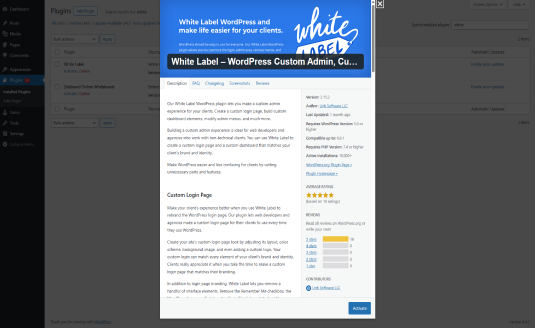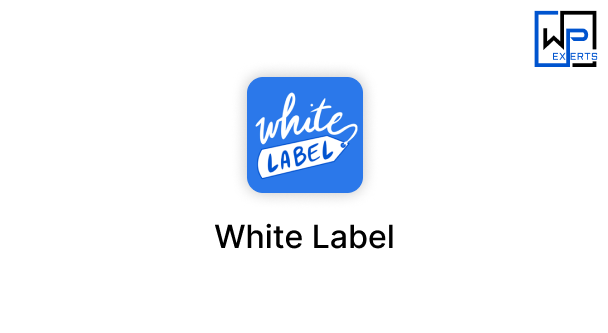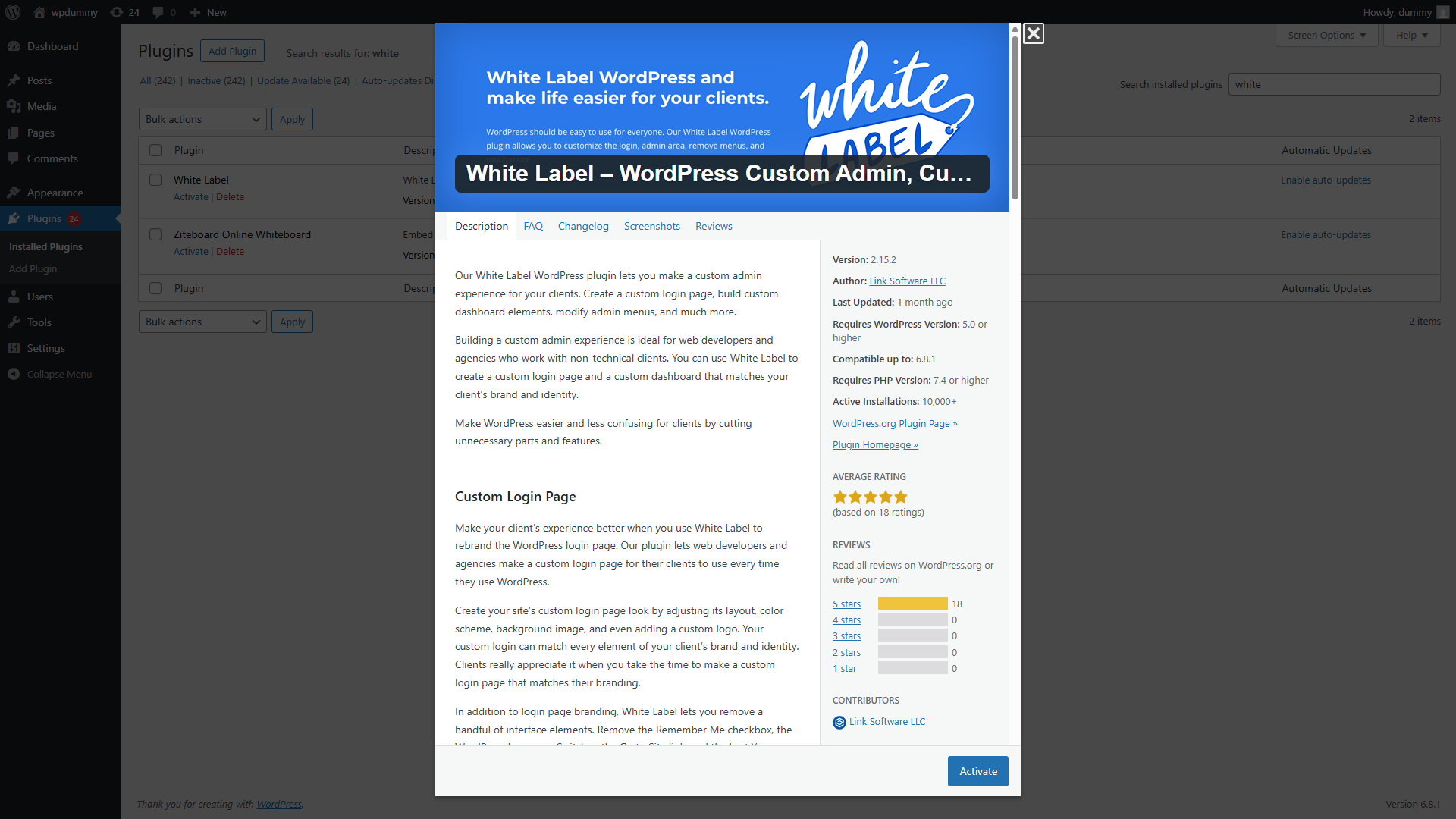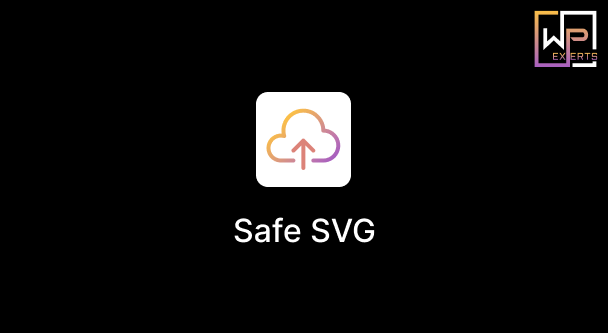White Label – WordPress Custom Admin, Custom Login Page, and Custom Dashboard is a powerful and versatile WordPress plugin designed to help developers, agencies, and freelancers completely customize the WordPress admin area for clients or users. It provides an easy and effective way to hide WordPress branding and replace it with your own—making the backend feel like a professionally branded, personalized platform. In this detailed overview, we’ll explore its core features, use cases, benefits, and why it’s a must-have tool in any developer’s toolkit.

Introduction to White Label Plugin
WordPress is an incredibly popular CMS, powering over 40% of websites globally. However, the default admin interface, login page, and dashboard bear WordPress branding, which might not align with a company’s identity or client expectations. The White Label plugin steps in to bridge this gap. It allows developers to rebrand the WordPress backend, providing a seamless and professional experience to users and clients.
This plugin is especially useful for:
- Agencies who create websites for clients and want to deliver a custom-branded experience.
- Freelancers aiming to offer added value with custom admin panels.
- Enterprises who use WordPress internally and want the interface to reflect company branding.
- Multisite networks needing unique dashboard experiences across sites.
Key Features
1. Custom Admin Panel
The plugin allows extensive customization of the WordPress admin interface:
- Remove or Rename Menu Items: Hide unwanted menu items (like Posts, Tools, or Plugins) or rename them to suit the client’s needs.
- Custom Admin Bar: Modify or remove items from the top admin bar.
- Custom Footer Text: Replace “Thank you for creating with WordPress” with your own company message.
- Custom Color Schemes: Match admin interface colors with your brand.
- Admin Notices Control: Suppress annoying update notices, warnings, or plugin messages that confuse clients.
These tools help deliver a clean, distraction-free admin interface tailored to the specific needs of the site’s users.
2. Custom Login Page
The login page is the first impression of the backend, and this plugin lets you fully redesign it:
- Upload Custom Logo: Replace the WordPress logo with your brand logo.
- Change Background & Colors: Use solid colors, gradients, or custom images.
- Modify Login Form Styles: Customize form appearance, border radius, padding, and more.
- Custom CSS Support: Add your own CSS rules for complete control.
- Custom Redirects: Redirect users to custom pages after login, logout, or registration.
This feature ensures the branding experience begins right at the login screen, reinforcing professionalism and trust.
3. Custom Dashboard Widgets
The default WordPress dashboard has widgets like “Welcome to WordPress” or “Quick Draft,” which may not be relevant for your clients. White Label allows:
- Removing Default Widgets: Get rid of unnecessary widgets that may confuse users.
- Adding Custom Widgets: Add helpful resources like client documentation, links to support, FAQs, or video tutorials.
- HTML, Text, or Rich Media Support: Display anything from simple instructions to embedded YouTube videos.
- Role-Based Widget Control: Show different widgets to different user roles.
This is perfect for onboarding clients and reducing support questions by offering useful, branded dashboard information.
4. User Role Management
The plugin allows fine-grained control based on user roles:
- Show/hide menus, widgets, or admin bar items per user role.
- Design different dashboard experiences for administrators, editors, authors, and contributors.
- Lock down areas that clients should not access, such as plugins or settings.
This not only improves security but also simplifies the experience for non-technical users.
Benefits of Using White Label
1. Improved Client Experience
By rebranding the WordPress admin area, your clients feel like they’re using a custom-built platform. This level of polish demonstrates professionalism and attention to detail, leading to higher client satisfaction.
2. Enhanced Brand Identity
Whether you’re working under your agency’s brand or your client’s, consistency across all digital touchpoints (including the backend) strengthens branding.
3. Simplified Interface
Removing unnecessary features from the admin panel reduces the learning curve for users and minimizes the chance of errors.
4. Stronger Security Posture
By hiding certain features from users who don’t need them, you reduce the risk of accidental (or intentional) misconfiguration.
5. Reduced Support Requests
Custom dashboard widgets and simplified interfaces mean clients are less likely to get confused, reducing the number of support tickets or calls.
Use Case Examples
Case 1: Freelancer Delivering a Site to a Non-Technical Client
A freelancer building a site for a small business can use the White Label plugin to remove unnecessary options like Tools, Appearance, and Plugins. They can replace the dashboard with a widget containing a “How to Update Your Website” guide, plus contact info for support.
Case 2: Agency Managing a Multisite Network
An agency managing multiple client sites via WordPress Multisite can use the plugin to deliver unique admin dashboards per site. One client may have a corporate-style login page and dashboard, while another gets a creative, colorful experience tailored to their brand.
Case 3: Enterprise Using WordPress for Intranet
An enterprise using WordPress as an internal portal can rebrand the admin interface to reflect company branding, provide IT support links, and restrict access to core settings so employees can focus on content creation.
Ease of Use
The plugin offers a user-friendly interface, typically found under the “Settings” or “Tools” menu in the WordPress dashboard. Most customization options include visual fields, toggles, and dropdowns—no coding required. However, developers can go further by adding custom CSS or using available hooks and filters to extend functionality.
Compatibility and Performance
White Label is built with performance in mind. It doesn’t add unnecessary bloat to your site and is compatible with most modern themes and plugins. It works seamlessly with page builders like Elementor, Beaver Builder, and WPBakery.
Moreover, the plugin supports multisite installations, making it ideal for agencies and enterprise environments. It’s frequently updated and well-supported, meaning it remains compatible with the latest versions of WordPress and PHP.
Free vs Pro Version
Many White Label plugins offer both free and premium (Pro) versions. While the free version provides core functionality (like logo replacement and menu hiding), the Pro version may include:
- Multiple user role configurations
- Advanced login page customization
- Import/export settings
- White label support (remove plugin branding)
- Additional dashboard widget layouts and options
If you are delivering multiple client projects or running an agency, the Pro version is often worth the investment.
Conclusion
The White Label – WordPress Custom Admin, Custom Login Page, and Custom Dashboard plugin is an invaluable tool for WordPress professionals. It transforms the default WordPress backend into a sleek, branded, and user-friendly environment tailored to your client’s needs. Whether you’re a freelancer, developer, agency, or enterprise, this plugin elevates the professionalism of your service while simplifying backend management for your users.
With a minimal learning curve and maximum customization, it’s no wonder this plugin is a favorite among WordPress developers who aim to deliver premium experiences to their clients. If you’re not already using it, it’s time to give your WordPress sites a polished, professional edge with White Label.





